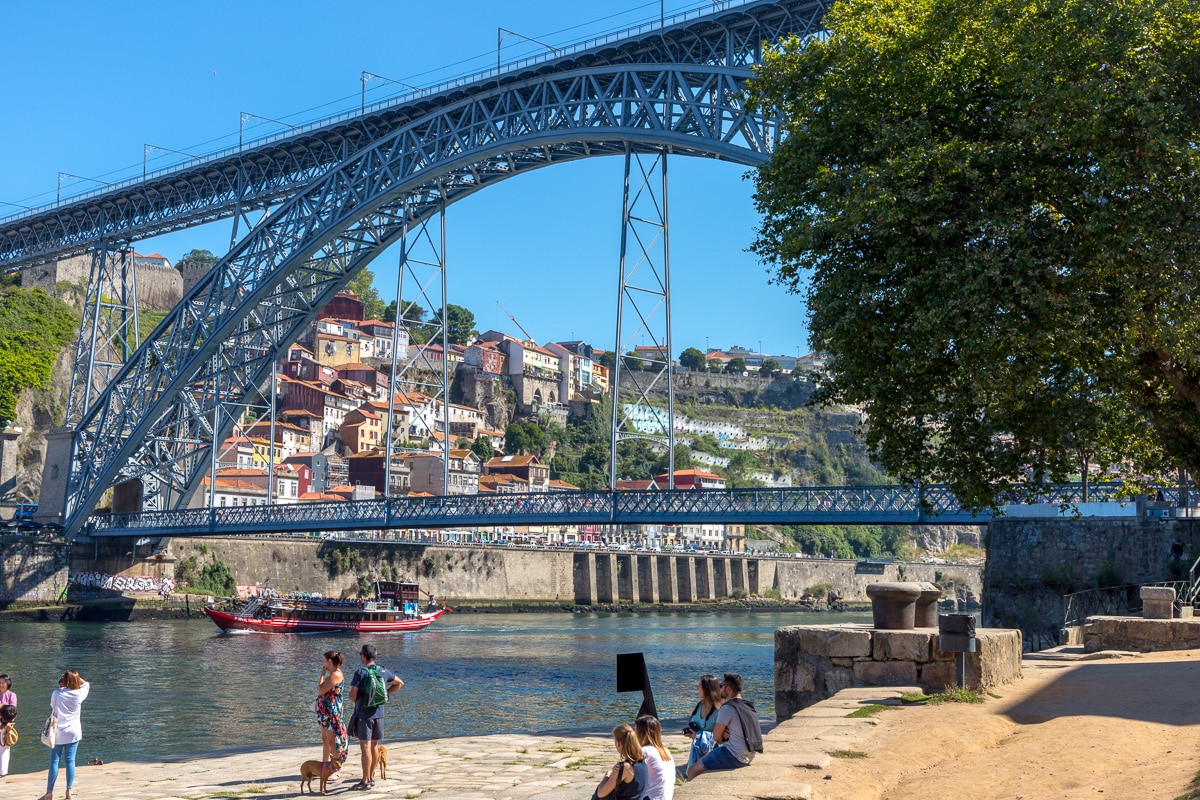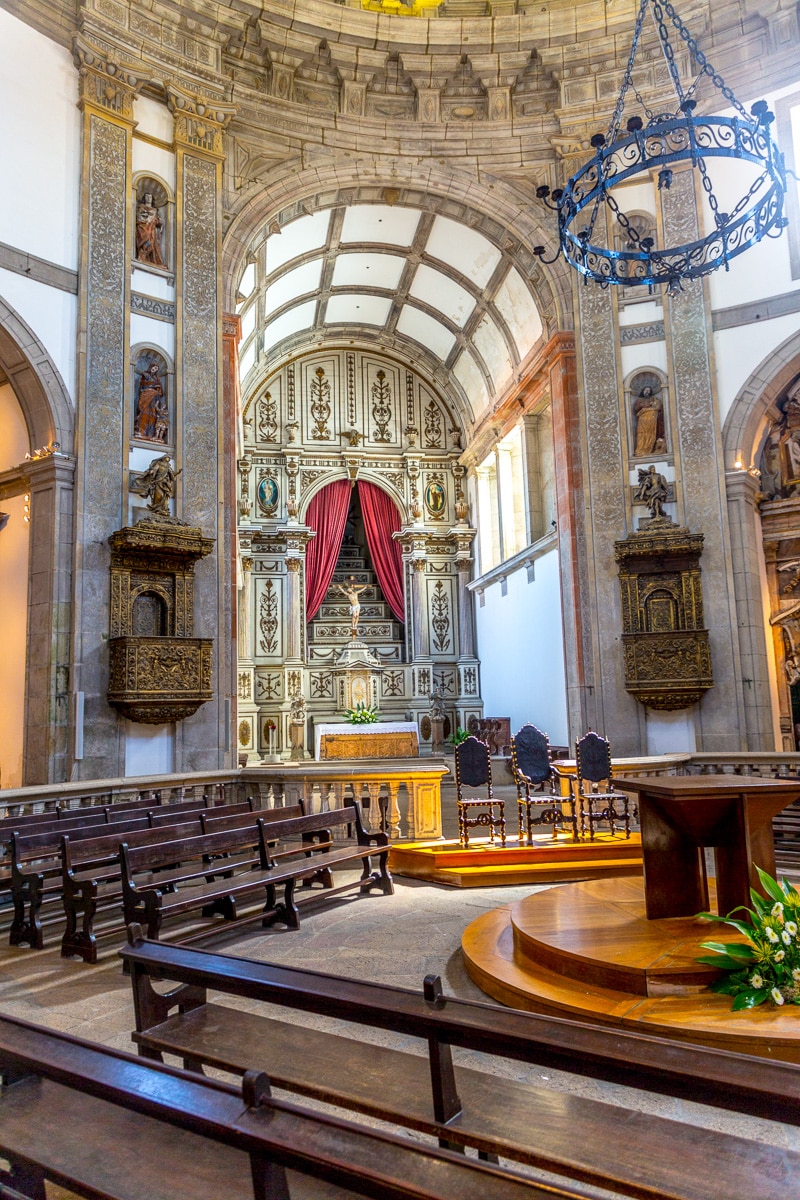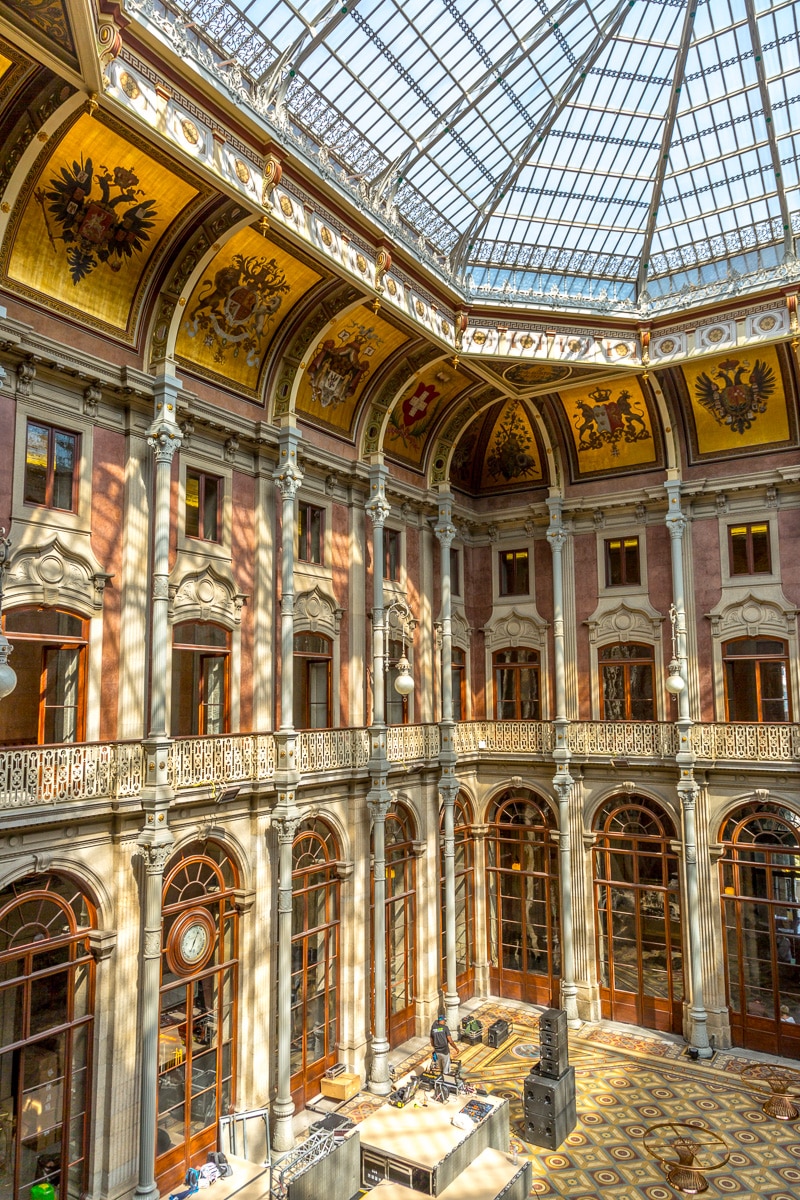August-October 2019 – Porto was a wonderful city, but there were too many sights to devote a post to each, so here is the first “six-pack” to highlight some of the sights, architecture, and history that Porto has to offer.
- Cais da Ribeira and the Luís I Bridge
- Serralves Museum & Villa
- Mosteiro da Serra do Pilar
- Palácio da Bolsa
- Igreja dos Clérigos
- Museu do Carro Eléctrico
Cais da Ribeira and the Luís I Bridge
 When we first arrived in Porto, we began our orientation by walking through town to the Rio Douro to the Cais da Ribeira or riverside pier. This riverside area is a chaotic, picturesque area lined with cafes, restaurants and shops overlooking the river and, on the opposite bank, the Port houses of Vila Nova de Gaia. All of the steep streets leading up and away from the river form a maze that weaves between the pastel-painted buildings.
When we first arrived in Porto, we began our orientation by walking through town to the Rio Douro to the Cais da Ribeira or riverside pier. This riverside area is a chaotic, picturesque area lined with cafes, restaurants and shops overlooking the river and, on the opposite bank, the Port houses of Vila Nova de Gaia. All of the steep streets leading up and away from the river form a maze that weaves between the pastel-painted buildings.
Looming high above the Cais da Ribeira, the Ponte Dom Luis I bridge links Porto with Vila Nova de Gaia over the Douro River. An iconic industrial symbol of Porto, the twin-level bridge carries metro trains on its top level and local road traffic below. Pedestrians can cross on both levels and the views from the 60 m (196 ft) high top deck are spectacular.
The metal, arched bridge opened in 1886 and was designed by a student of Gustave Eiffel, of Eiffel Tower in Paris fame.
Serralves Museum & Villa
 The Fundação de Serralves comprises a contemporary art museum, a park and gardens, and a villa all set on nearly 18 hectares (45 acres) of land in western Porto.
The Fundação de Serralves comprises a contemporary art museum, a park and gardens, and a villa all set on nearly 18 hectares (45 acres) of land in western Porto.
The Serralves Museum or Museu de Arte Contemporânea, opened in 1999 and boasts 14 exhibition galleries across three floors. Its permanent collection features works from the late 1960s to the present, with multiple high-profile temporary exhibitions.
Then there is the villa, Casa de Serralves, considered the best example of art deco architecture in Portugal. Inside the villa, which was originally a private residence, temporary art exhibits are hosted throughout the year.
The villa overlooks luxurious terraced gardens featuring tree-lined avenues, topiaries, pergolas, lush lawns, exotic plants, winding pathways and even a farm. Permanent sculptures pepper the grounds as well.
Mosteiro da Serra do Pilar
 Situated high above the south side of the Rio Douro, the 36 m (118 ft) Church of Serra do Pilar dominates the skyline. The unique design of the Monastery of Serra do Pilar’s was influenced by both Renaissance and Mannerist styles. The church and its cloister are both circular with identical diameters, but circular cloisters are rather rare.
Situated high above the south side of the Rio Douro, the 36 m (118 ft) Church of Serra do Pilar dominates the skyline. The unique design of the Monastery of Serra do Pilar’s was influenced by both Renaissance and Mannerist styles. The church and its cloister are both circular with identical diameters, but circular cloisters are rather rare.
In 1947 most of the monastery grounds were converted into a military barracks, and is still used by the Portuguese army. This became apparent when, as part of our tour of the church, we were escorted by our guide through a stone hallway to go up to the roof. At this point, we were met by a soldier in uniform who led us up the tight spiral staircase to the terrace that encircles the domed cupola where we enjoyed the spectacular, 360° view over the Douro River, the Dom Luis I bridge, and Porto.
Palácio da Bolsa
 Porto’s old stock exchange is one of the most-visited sites in Porto. It was built next to the Church of São Francisco after its cloisters burned down during the Siege of Porto in 1832. The exterior has a Neoclassical design, while the interiors were embellished right up to the start of the 20th century.
Porto’s old stock exchange is one of the most-visited sites in Porto. It was built next to the Church of São Francisco after its cloisters burned down during the Siege of Porto in 1832. The exterior has a Neoclassical design, while the interiors were embellished right up to the start of the 20th century.
We took a tour of the interior with a guide and were impressed by the octagonal, glass-domed Pátio das Nações (Hall of Nations) and many of the other richly decorated rooms. However, the Moorish Revival Salão Árabe, was the most notable. It is a stupendous ballroom with stucco walls filled with complex Moorish designs, then gilded with 18kg (almost 40 lbs) of gold, and a intricate parquet floor made from exotic woods such as mahogany, rosewood, satinwood, rosewood and maple.
This massive building was used to influence European bankers and investors alike with the richness of its sculptures, decorative carvings, plasterwork, frescos, chandeliers and tiles.
Igreja dos Clérigos
 The Igreja dos Clérigos was begun in 1732 and completed in the 1750’s, with its monumental stairway in front of the church finished later in the decade. In typical Baroque style, the main façade of the church is decorated with motifs of garlands and shells.
The Igreja dos Clérigos was begun in 1732 and completed in the 1750’s, with its monumental stairway in front of the church finished later in the decade. In typical Baroque style, the main façade of the church is decorated with motifs of garlands and shells.
The interior of the church has an unusual oval floor-plan and is lavishly decorated with gilt woodwork, and the main chapel’s beautiful Rococo altarpiece with fabricated in four-color marble.
The 75.6 m (249 ft) high tower of this Baroque church is a beautiful monument that dates to 1763 and can be spotted from most parts of Porto and was the tallest building in the country when it was completed.
You can climb the tower, as we did, and the 240 steps will lead you to a full 360 degree view from the narrow observation deck, but the view at the top is quite spectacular.
Museu do Carro Eléctrico
 We were out wandering along the north side of the Douro river and happened across this Museum, housed in the old central power plant of the tram system. Dozens of beautifully restored old trams are displayed – from early 1870s models once pulled by mules to streamlined, bee-yellow 1930s numbers to “modern” trams that date back to the 1950’s and 1960’s. The control room of the power plant has been nicely restored to its former technological glory.
We were out wandering along the north side of the Douro river and happened across this Museum, housed in the old central power plant of the tram system. Dozens of beautifully restored old trams are displayed – from early 1870s models once pulled by mules to streamlined, bee-yellow 1930s numbers to “modern” trams that date back to the 1950’s and 1960’s. The control room of the power plant has been nicely restored to its former technological glory.









Kaydie Vistelle
14 Dec 2019Wow fantastic photos and writing!
I’m still leading my tours of Provence and now in the Dordogne as well.
Have you visited that area?
We met several years ago at the Haile village market in Gainesville.
So happy to see that you’re still loving your amazing adventure!
Jeannie
26 Dec 2019It’s great to hear from you Kaydie! We’ll plan a trip to Gainesville before we leave again, so we can share our adventures in France. The Dordogne is a great region; we’re going to the Loire Valley next. So many beautiful areas of France to see!
Wayne
12 Dec 2019Great photos! and dialogue as always!
Jeannie
12 Dec 2019Thanks Wayne!
Cathi
12 Dec 2019So diverse! Thanks for the stroll.
Jeannie
12 Dec 2019Yes! Though all the hills made strolling a bit more taxing than Florida. Good exercise to balance all the good calories!
Linda
11 Dec 2019Great pictures and narratives. Feel like I was there with you. Fabulous city and lots to offer tourists.
Jeannie
12 Dec 2019We thought we’d like Portugal, and it was great! We’d love to return, but still so many other places to visit. It would be pretty good if we could align our travel plans and meet somewhere. Something to discuss when we meet in Florida again.
Missy Ortega
11 Dec 2019The Ponte Dom Luis I bridge is very impressive. And I really like the beautiful photos of the railway trams. Thank you for sharing this.
Jeannie
12 Dec 2019The tram museum was an interesting step back in time. Glad you enjoyed!
Alice Mathias
10 Dec 2019Loved your 6 pack!
Jeannie
12 Dec 2019And there is another in the works!
PAULA A MILLIGAN
10 Dec 2019All that comes to mind is “WOW!”
Thank you for sharing.
Jeannie
12 Dec 2019Wait till you see pictures of Lisbon, we said wow around every corner! But yes, all other places were pretty good as well.
Linda Pina
10 Dec 2019Fabulous pictures… Love this place
Jeannie
12 Dec 2019We really liked Portugal and all the places we visited (and food we ate…). Happy to share it with you.